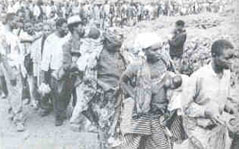Barely surviving
 THE World Conservation Union (IUCN) is distressed about the way relief agencies like the Red Cross and Christian Action Research and Education are treating the Virunga National Park, Africa's oldest wildlife sanctuary. These agencies are aiding Rwandan refugees camping on the Zaire-Rwanda borders rubbing shoulders with the park. In a report circulated at the United Nations Educational, Scientific and Cultural Organization's (UNESCO) World Heritage Committee meeting, held in mid-December 1994, the IUCN asked the organisation to prioritise the park on a "danger list" of world heritage sites at imminent risk of destruction.
THE World Conservation Union (IUCN) is distressed about the way relief agencies like the Red Cross and Christian Action Research and Education are treating the Virunga National Park, Africa's oldest wildlife sanctuary. These agencies are aiding Rwandan refugees camping on the Zaire-Rwanda borders rubbing shoulders with the park. In a report circulated at the United Nations Educational, Scientific and Cultural Organization's (UNESCO) World Heritage Committee meeting, held in mid-December 1994, the IUCN asked the organisation to prioritise the park on a "danger list" of world heritage sites at imminent risk of destruction.
According to Jim Thorsell, senior adviser on natural heritage at the iucn and the author of the report, around 40,000 people enter the park everyday, and "between 410 and 770 tonnes of forest products are taken out of the park daily". But what Thorsell is really perturbed about is that the relief agencies have set up a "defecation zone" and a dump for medical wastes inside the park itself. "The risk of disease transmission to wildlife is serious," he says. The iucn has also alleged that the un High Commission for Refugees (UNHCR) could have prevented the crisis.
The UNHCR, on the other hand, has very clearly stated that it had no time to worry about the Virunga when thousands of homeless and destitute people were pouring in from across the border. "We didn't have any alternative but to set up the camps. It was a life and death situation," declares a senior official of the organisation.
The IUCN concedes that the unhcr had a difficult agenda. The park provided spare land with adequate water and wood. But Thorsell and his colleagues strongly believe that the relief agencies should have acted more responsibly, and not added to the damage.
There is no doubt whatsoever that the Virunga needs urgent attention. It has been dogged by problems even before the civil war broke out in Rwanda. Political instability in Zaire has left the park bereft of funds and a proper forest surveillance system. Between 1989 and 1994, the hippopotamus population in the park halved to 11,000, thanks to indiscriminate poaching. A patrol funded by unesco in 1993 found an abondoned poacher's camp with remains of 155 hippopotamii "and a mound of buffalo carcasses too numerous to count". Besides, Zairean soliers who have practically taken over the northern side of the park are regularly seen sneaking out truckloads of wood.
Thorsell believes that the situation can be salvaged by drawing up contingency plans to prevent future refugee crises from turning into environmental crises as well. The world cannot afford to let the Virunga national park -- famous for its rich biodiversity -- just go the way of all flesh.
